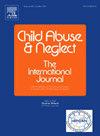HPA-axis multilocus genetic variation moderates longitudinal link between friendship quality and adolescent depressive symptoms after childhood abuse
IF 3.4
2区 心理学
Q1 FAMILY STUDIES
引用次数: 0
Abstract
Background
Studies indicate that genetic variations associated with the functioning of the hypothalamic-pituitary-adrenal (HPA) axis can influence the relationship between environmental stressors and depressive symptoms, but examining gene-environment interactions with single polymorphisms limits power.
Objective
This study examined a multilocus genetic profile score (MGPS) for HPA-axis function and investigated its interaction with childhood abuse, friendship quality, and the longitudinal trajectory of depressive symptoms among adolescents.
Method
A total of 931 adolescents (Mage = 14.21, 54.6 % girls) were assessed at baseline and followed across three additional waves at six-month intervals over two years. Additive MGPS were calculated using six single nucleotide polymorphisms within HPA-axis genes (NR3C1, NR3C2, SKA2, FKBP5). For the final analysis, 483 participants were included based on reported childhood abuse (score ≥ 1) and valid genetic data.
Results
Latent growth modeling revealed upward trajectories in both friendship quality and depressive symptoms. The latent growth interaction model revealed a significant three-way interaction (G × E1 × E2), where higher HPA-axis multilocus genetic variation risk scores strengthened the interaction between childhood abuse and friendship quality in predicting depressive symptoms trajectories. Specifically, under high HPA-axis multilocus genetic variation risk scores and childhood abuse, a higher increase in friendship quality predicted a decline in depressive symptoms, while lower friendship growth predicted an increase, consistent with the differential susceptibility model.
Conclusions
These findings suggest that enhancing friendship quality may buffer against depressive symptom escalation among adolescents with heightened genetic and environmental vulnerabilities. Targeting peer relationships could serve as a promising direction for early intervention efforts.
hpa轴多位点遗传变异调节童年虐待后友谊质量与青少年抑郁症状之间的纵向联系
研究表明,与下丘脑-垂体-肾上腺(HPA)轴功能相关的遗传变异可以影响环境应激源与抑郁症状之间的关系,但通过单一多态性检测基因-环境相互作用的能力有限。目的研究hpa轴功能的多位点遗传谱评分(MGPS),并探讨其与童年虐待、友谊质量和青少年抑郁症状的纵向轨迹的相互作用。方法共931名青少年(年龄为14.21岁,女孩占54.6%)在基线时进行评估,并在两年内每隔6个月进行另外三次随访。利用hpa轴基因(NR3C1、NR3C2、SKA2、FKBP5)内的6个单核苷酸多态性计算加性MGPS。在最终的分析中,根据报告的儿童虐待(得分≥1)和有效的遗传数据,纳入了483名参与者。结果潜势增长模型揭示了友谊质量和抑郁症状的上升轨迹。潜在生长相互作用模型显示了显著的三方相互作用(G × E1 × E2),其中较高的hpa轴多位点遗传变异风险评分增强了童年虐待与友谊质量在预测抑郁症状轨迹方面的相互作用。具体而言,在高hpa轴多位点遗传变异风险评分和童年虐待的情况下,友谊质量的高增长预测抑郁症状的下降,而友谊增长的低预测抑郁症状的增加,这与差异易感性模型一致。结论在遗传和环境脆弱性较高的青少年中,提高友谊质量可以缓冲抑郁症状的升级。针对同伴关系可以作为早期干预工作的一个有希望的方向。
本文章由计算机程序翻译,如有差异,请以英文原文为准。
求助全文
约1分钟内获得全文
求助全文
来源期刊

Child Abuse & Neglect
Multiple-
CiteScore
7.40
自引率
10.40%
发文量
397
期刊介绍:
Official Publication of the International Society for Prevention of Child Abuse and Neglect. Child Abuse & Neglect The International Journal, provides an international, multidisciplinary forum on all aspects of child abuse and neglect, with special emphasis on prevention and treatment; the scope extends further to all those aspects of life which either favor or hinder child development. While contributions will primarily be from the fields of psychology, psychiatry, social work, medicine, nursing, law enforcement, legislature, education, and anthropology, the Journal encourages the concerned lay individual and child-oriented advocate organizations to contribute.
 求助内容:
求助内容: 应助结果提醒方式:
应助结果提醒方式:


